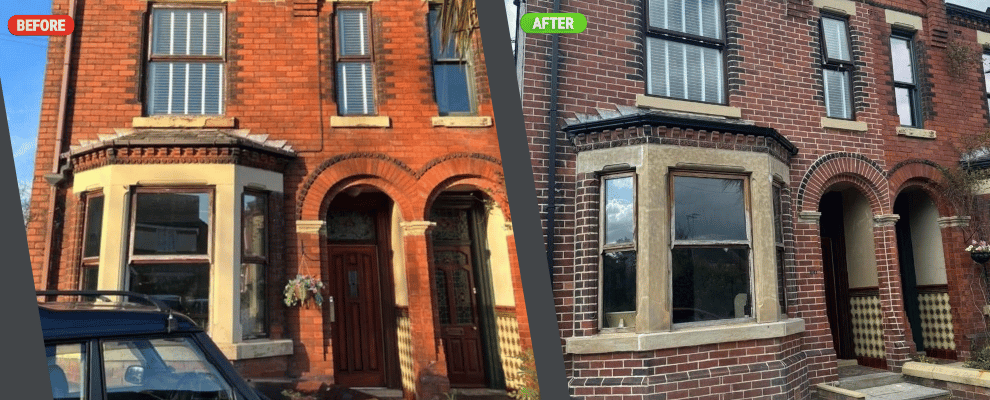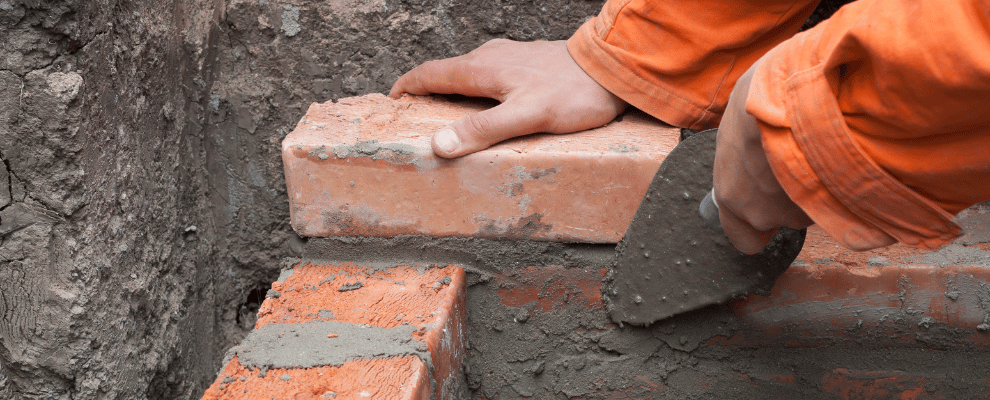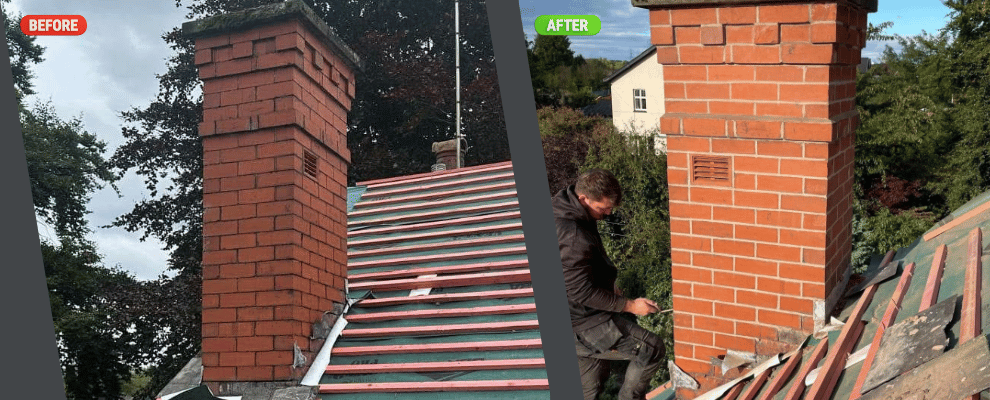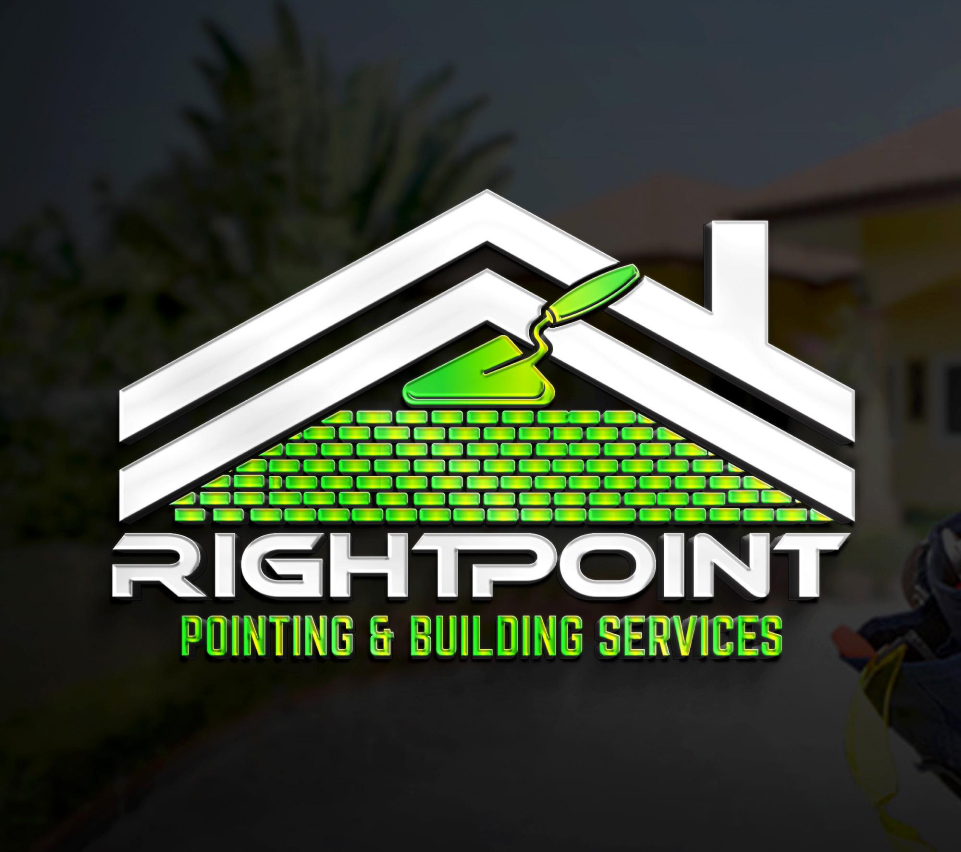Repointing Brickwork: Just About Everything You Need to Know
Even the most durable structures and buildings will start to look weathered at some point—especially in the UK, where we experience harsh weather conditions. At Right Point, repointing brickwork is our bread and butter. Based just outside of Manchester in the town of Leigh, we know firsthand how quickly Northwest typical weather can affect the look and longevity of your brickwork. From heavy rain and freezing temperatures to the occasional gust of wind, these elements can lead to the deterioration of mortar joints, causing cracks and gaps. This makes repointing an essential part of maintaining your property’s integrity and appearance in the long term. As pointing experts, we’ve put together this guide on repointing brickwork, from costs, tools for repointing and how you can have your home or business looking beautiful again.
What is pointing?
In simple terms, pointing refers to the process of repairing or renewing the mortar joints between bricks or stones in a structure. Over time, weather exposure - especially in areas with harsh conditions - can cause the mortar to wear down, crack, or crumble, leading to potential structural issues. Repointing or raking out involves carefully removing the old mortar and replacing it with fresh material, restoring both the strength and aesthetic of your brickwork. Regular pointing maintenance helps protect your property from water damage and ensures that your masonry remains secure for years to come. Mortar will hold up for about 25 years or so. As we’re based in the Northwest, we cover a lot of historic towns such as Leigh, Tyldesley and Atherton. As you can imagine, we service a lot of older buildings that haven’t had much work done for quite some time.

Benefits of Pointing & Repointing
You may wonder, why do I need my bricks pointing? There are quite a few benefits to pointing, both functional, aesthetic or maybe you’re coming to sell a property and you want to get what it’s worth. Pointing and repointing are similar processes but are often confused. Pointing is the initial process of creating a visible joint between bricks. Repointing is a repair of existing pointing that has become damaged and needs refilling with new mortar.
Structural
The mortar joints in brickwork do much more than fill gaps - they are essential for the overall stability of a building. When these joints begin to deteriorate, the integrity of the entire structure can be at risk. Repointing is crucial to maintain a solid bond between the bricks, reinforcing the building's strength and preventing further damage. Properly maintained pointing ensures that your brickwork remains secure and reliable for years to come.
Weatherproof Your Home
Mortar joints serve as a protective barrier against water penetration. When the pointing is in good condition, it helps prevent moisture from seeping into the walls, safeguarding the interior from issues like mold growth and the deterioration of surfaces. Proper repointing ensures that your property remains protected from the damaging effects of water ingress.
Your beautiful home again
A well-executed repointing job can transform the look of a brick wall. It refreshes the appearance of the masonry, giving it a neat, uniform finish that enhances the overall aesthetic of the building. Proper pointing restores a timeless, polished look, boosting the curb appeal and charm of your property.

Can you repoint brickwork yourself?
Can pointing be done on a DIY level? Yes, it’s possible, but if you’re not an experienced professional it may not look the best. One of the main points of repointing brickwork is to improve the overall aesthetic of your home. If a bad job is done, then the overall appearance of the house won’t look great.
What’s the process?
- Free Pointing Inspection: Before we start any work, an examination must be carried out of the structure. This is to assess the extent of which the building needs repointing.
- The Repointing Mix: What mix you use for repointing your brickwork will depend on what was used originally. You want to get as close to the original materials as possible, otherwise any repairs carried out will stick out like a sore thumb. Obtaining the right materials goes beyond just aesthetics. The old and new materials must be similar as they will share the same give. If they don’t share the same give, it can result in cracks over time.
- Out with the old: Once the correct materials have been obtained, we’ll start the process of removing the old or damaged mortar from the joints. This is to get rid of any old material that could cause issues in the future. The joints are then flushed before filling.
- Applying new mortar: Starting with the most severe areas first, we fill the deepest recessions with mortar, applying several layers to build up to your desired look.

What Is Mortar and Which Mortar Mix Is Best for Repointing?
Mortar is a mixture of cement, sand, and water, often enhanced with plasticizer or lime, used to bond bricks or stones in masonry construction. Unlike concrete, which uses coarser sand, mortar relies on finer sand to create a workable consistency suited for building or repointing.
Key Components of Mortar
- Sand: The primary ingredient in mortar, varying in texture depending on its source (land or sea-dredged). Finer sand is preferred for mortar mixes.
- Cement: Acts as a binding agent, giving the mortar its strength.
- Plasticizer: A chemical additive that improves the workability and consistency of the mortar.
- Lime: Often used in older buildings, lime is a gentler alternative to plasticizers. It’s beneficial for its flexibility, reduced risk of cracking, and ability to allow trapped moisture to escape.
Choosing the Right Mortar Mix
The proportions of sand, cement, lime, and plasticizer in a mortar mix depend on the structure's needs and the weather conditions it will face. For example, a standard mortar mix for repointing in normal conditions typically includes:
- 1 part Portland cement
- 1 part lime
- 4 parts sand
If you're trying to match existing mortar, it may require some experimentation with ratios and even cement dyes to achieve a perfect colour match.
The Benefits of Lime Mortar
Lime is a popular choice for repointing because it sets more slowly than cement-based mixes, reducing the risk of shrinkage and cracks. It’s also more breathable, allowing moisture to escape the structure, which is especially important for older buildings. In colder conditions, additives can be used to protect mortar from frost and to control the setting time. Sifting sand before mixing can improve consistency and make it easier to apply. By selecting the right mortar mix and adjusting it to suit your building’s needs, you can ensure strong, durable, and weather-resistant brickwork.
The Different Types of Pointing
1. Flush Pointing
Flush pointing is a sleek and modern technique where the mortar is levelled flush with the brick surface. This style provides a smooth finish that effectively prevents water penetration, making it ideal for homes and commercial properties exposed to heavy rainfall.
2. Recessed Pointing
With recessed pointing, the mortar is pressed back from the surface of the bricks, creating a concave joint. This style highlights the texture of the brickwork, adding depth and character. However, recessed pointing may not be the best option for walls exposed to harsh weather, as the set-back mortar can be more vulnerable to moisture.
3. Weathered Pointing
Also known as struck pointing, this technique slopes the mortar downward at an angle, allowing rainwater to run off easily. Weathered pointing is not only practical but also adds a distinctive shadow line that enhances the look of the brickwork.
4. Tuck Pointing
Tuck pointing is a decorative approach that uses two contrasting colours of mortar. The first matches the bricks to create a seamless look, while the second—a fine, white line—gives the appearance of crisp, precise joints. It’s a popular choice for restoring historic buildings to their former glory.
5. Beaded Pointing
For a more decorative finish, beaded pointing involves creating a convex bead along the joint using a special tool. While visually appealing, this style can be more prone to damage and may require extra maintenance over time.
Why Choosing the Right Pointing Style Matters
The type of pointing you choose can significantly impact your masonry's durability, weather resistance, and aesthetic appeal. At Right Point, we’re experts in all aspects of pointing and brickwork. Whether you’re looking to restore your home’s charm or protect it from the elements, we can help. For a free repointing quotation, call us today on 07979754342 or 07498421411.
FAQs
We’ve put together answers to some of the most common questions about our repointing services. If there’s something we haven’t covered, don’t hesitate to get in touch through our contact page.
How do I know if my brickwork needs repointing?
Look for signs like crumbling mortar, gaps in the joints, or water ingress. If your mortar is no longer holding bricks securely, it’s time for repointing.
What is the best time of year to repoint brickwork?
Repointing is best done during mild weather, typically in spring or autumn, to ensure the mortar sets correctly without being affected by extreme heat or frost.
Can repointing stop damp in my home?
Yes, repointing can help prevent damp by sealing gaps in the mortar where water might penetrate, protecting your home from moisture-related damage.
How long does repointing last?
Properly done repointing can last 30–50 years, depending on the quality of the materials and exposure to weather.
How much does repointing brickwork cost?
The cost varies depending on the size of the area, the type of mortar used, and the labour involved. It's best to get a quote for an accurate estimate.
Is repointing a DIY job or should I hire a professional?
While minor repairs might be tackled by experienced DIYers, full repointing requires professional skills to ensure structural integrity and a neat finish.
How long does repointing take?
The duration depends on the size and condition of the area being repointed, but most jobs are completed within a few days to a week.
Can repointing improve the energy efficiency of my home?
Yes, repointing can help reduce draughts and heat loss through gaps in the mortar, improving your home's insulation.
What are the alternatives to repointing brick?
If your brickwork is showing signs of wear but repointing isn't an option, there are alternatives to consider. Brick sealing can help protect the masonry by creating a water-resistant barrier, while crack stitching uses stainless steel rods to stabilize damaged walls. For a complete refresh, rendering or cladding can provide a new, durable surface over existing bricks. Each option has its advantages depending on the condition of your brickwork and your budget. At Right Point, we can assess your masonry and recommend the best solution to restore its strength and appearance.
Get in touch
If you have any queries or would like to register your interest in RightPoint, please do get in touch on any of the following:
